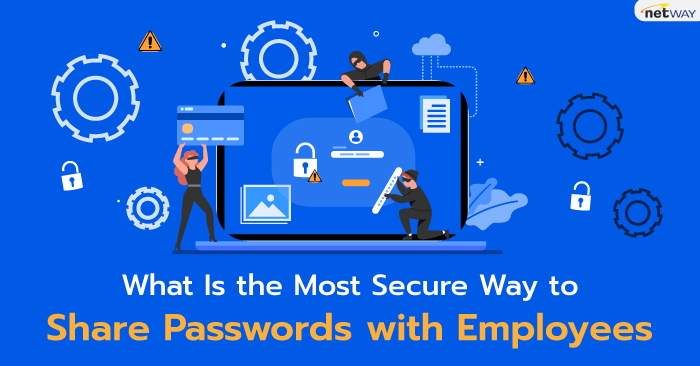-
Welcome to My Website
This is a text box. Write your own content here. This is an excellent place for you to add a paragraph.
What Is the Most Secure Way to Share Passwords with Employees

“แชร์รหัสผ่านในองค์กรอย่างไร ให้ปลอดภัยที่สุด”
กว่า 80% ของปัญหาข้อมูลรั่วไหล มีสาเหตุมาจากการแชร์ Password กับบุคคลอื่น แต่ใน 1 องค์กรบางครั้งก็จำเป็นจะต้องแชร์กับทีม หรือนอกทีม แล้วเราควรจัดการอย่างไรให้เรื่องนี้ปลอดภัย
✅Centralized Password Management
✅End-to-End Encryption
✅Secure Password Sharing Features
✅Multi-Factor Authentication (MFA)
✅Password Generation and Complexity
✅Audit Trails and Activity Monitoring
✅Secure Sharing with Third Parties
ถ้าคุณอยากเพิ่มความปลอดภัยให้กับเว็บไซต์ ระบบการใช้งาน หรือข้อมูลที่ใช้ร่วมกัน Netway Communication พร้อมให้คุณติดต่อได้ 24 ชม.
Contact Netway Communication (24x7) 📲: 02 055 1095 📧: support@netway.co.th 👨💻Web chat: https://netway.co.th/ 💙Facebook Messenger: @netway.official https://www.facebook.com/netway.official 💚Add Line ID: @netway https://bit.ly/line-netway
#Cybersecurity #PasswordSecurity #PasswordManager #DataSecurity #TechSafety #Password
What Is the Most Secure Way to Share Passwords with Employees

Breached or stolen passwords are the bane of any organization’s cybersecurity. Passwords
cause over 80% of data breaches. Hackers get in using stolen, weak, or reused (and easily
breached) passwords.
But passwords are a part of life. Technologies like biometrics or passkeys haven’t yet replaced them. We use them for websites, apps, and more. So, companies need a secure way to share passwords with employees. As well as help them manage those passwords more effectively.
Cybersecurity threats are rampant and safeguarding sensitive information has never been more critical. Properly managing passwords securely is a top priority. At the same time, employees deal with more passwords than ever. LastPass estimates that people have an average of 191 work passwords.
Since you can’t get around passwords, how do you share them with employees safely? One solution that has gained popularity in recent years is using password managers.
Why Use a Business Password Management App?
Password managers give you a secure digital vault for safeguarding passwords. The business versions have setups for separating work and personal passwords. They also have special administrative functions so companies never lose a critical password.
Centralized Password Management
End-to-End Encryption
Leading password managers use robust encryption techniques to protect sensitive data.
End-to-end encryption scrambles passwords. It turns them into unreadable text when
stored and transmitted. This makes it nearly impossible for unauthorized users to access
the information.
When sharing passwords with employees, encryption provides an extra layer of security. It helps ensure that the data remains confidential even during transmission.
Secure Password Sharing Features
Password managers often come with secure password-sharing features. They allow
administrators to share passwords with team members. And to do this without revealing
the actual password.
Instead, employees can access the required credentials without seeing the characters. This ensures that employees do not have direct access to sensitive information. This feature is particularly useful when onboarding new team members. As well as when collaborating on projects that require access to specific accounts.
Multi-Factor Authentication (MFA)
Many password managers support multi-factor authentication. This adds an extra and important layer of security. MFA requires two or more forms of verification before accessing an account.
Password Generation and Complexity
Password managers often come with built-in password generators. They create strong, complex passwords that are difficult to crack. When sharing passwords with employees, employers can use these generated passwords. They ensure that employees are using strong, unique passwords for each account.
Audit Trails and Activity Monitoring
Monitoring is a valuable feature offered by many password managers. It provides the ability to track user activity and access history. Admins can track who accessed which passwords and when. This provides transparency and accountability within the organization.
Secure Sharing with Third Parties
Ready to Try a Password Manager at Your Office?
บทความในส่วนนี้
-
November 2025 - Netway Combo ข่าวสารรายเดือน พ.ย. 2568
Updated on 2025-11-06 09:20:17
-
ข่าวดี! Microsoft 365 Enterprise Plan สามารถซื้อพร้อม Microsoft Teams ได้อีกครั้งแล้ว
Updated on 2025-11-05 04:07:35
-
การใช้ประโยชน์จาก Microsoft Forms สำหรับการรวบรวมข้อมูล
Updated on 2025-11-06 02:51:43
-
Microsoft 365 Business Premium: ความปลอดภัยที่ทุกองค์กรต้องใส่ใจ
Updated on 2025-11-03 02:50:03
-
ประกาศปรับราคาขาย cPanel License ประจำปี 2026
Updated on 2025-10-17 10:13:03
-
ความแตกต่างระหว่าง DigiCert Document Signing Certificates ทั้ง 3 แบบ
Updated on 2025-10-15 03:15:24

-
Domain
-
Hosting
-
Cloud & Managed
-
SSL
-
Email
- เรียนรู้เพิ่มเติม
- Microsoft 365 รุ่นต่างๆ
- Microsoft 365 สำหรับธุรกิจ
- Microsoft 365 สำหรับใช้งานที่บ้าน
- ทดลองฟรี
- G Suite
- เทคนิคลดต้นทุนอีเมล Microsoft 365 มากกว่า 28%
- เทคนิคลดต้นทุนอีเมล G Suite มากกว่า 19%
- Zimbra-Based Email
- Traditional Email by cPanel
- Physical to Cloud Migration
- Exchange Server to Microsoft 365 Migration
- G Suite to Microsoft 365 Migration
- Microsoft 365 to G Suite Migration
- Cloud to Cloud Migration
-
Microsoft
-
Google
-
Marketing
-
Others
-
Blog
-
Microsoft Teams
-
microsoft-365-business-premium
-
test-slide
-
Order
-
Promo